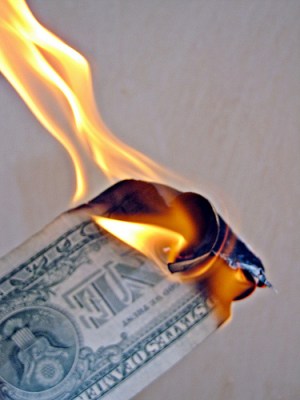The Facebook IPO is expected to usher in a day of massive trading volumes on the markets, and some believe that might translate to a lift for some tech stocks. But one that could really use some help has just been served another course of bad press: Nokia is apparently burning through its cash reserves — fast.
The company, for years the biggest mobile phone maker in the world, has fallen on very tough times, as competition from companies like Samsung, Apple and a barrage of inexpensive device makers, have translated into declines in sales, market share and profitability.
That’s now translating into what has been identified as another issue: the burning of the cash pile. In the last five quarters, Nokia has burned through €2.1 billion ($2.7 billion) from its cash reserves. Analysts polled by Reuters on average believe that at the rate Nokia is going, it will go through another €2 billion ($2.5 billion) in the next three quarters, with the total current cash pile of €4.9 billion ($6 billion) gone within two years.
To put that in some context, in 2007 Nokia had cash reserves of €10 billion in 2007 ($12.7 billion). That points to its cash pile burn accelerating — a result of the fact that the company has been trying to transform its business, which requires investment, while at the same time seeing massive sales drops:
In the company’s last quarterly earnings, reported April 18, Nokia reported that overall revenues were down by $4 billion (€3.4 billion) to $9.7 billion (€7.4 billion). Smartphones, the core of Nokia’s fightback strategy, declined by more than 50 percent both in revenues and unit sales, and the company saw a 40 percent drop in revenues from devices, its biggest business, with sales in those now at €4.2 billion. Nokia also swung to an operating loss of $1.7 billion, blaming the double-whammy of competition from Apple/Google as well as restructuring costs, as the company has pushed to put a stronger emphasis on its new line of smartphones in a race to gain back its rapidly disappearing market share in the higher-margin end of the smartphone market.
Nokia currently has two tranches of credit bonds outstanding: bonds of €1.25 billion euros at 5.5 percent maturing in 2014 and €500 million of notes at 6.75 percent due in 2019. These have now reached the lowest investment grade status at S&P, Fitch and Moody’s with negative outlook.
“I would not rule out the possibility of Nokia being downgraded further,” Nancy Utterback, a credit strategist at Aviva Investors, told Reuters. “The company is in a negative spiral that will be hard to reverse.”
Reuters does also point out some bright spots. The company is expected to sell 20 million of its new Windows Phone-based smartphones this year, and 46 million next year. And if the company continues on its cost-reducing course, it could end 2012 with €2.8 billion ($3.6 billion) in net cash this year.
And there is another possibility that we will likely see raised more and more: a “white knight” in the form of a Microsoft acquisition. The software company is already heavily entwined with Nokia over the use of the Windows Phone OS — paying Nokia $1 billion annually for this — a relationship that could well deepen if Nokia’s problems continue to grow.
